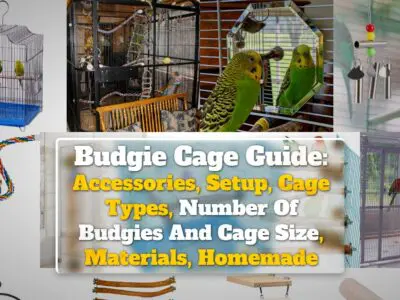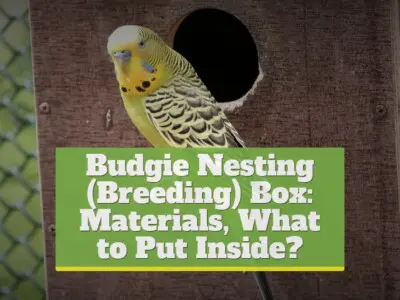Many budgie owners and fanciers often want indoor and outdoor budgie aviaries. However, it would help if you learned about budgie aviaries before taking any action.
There are two main types of budgie aviaries: indoor and outdoor. Both aviary types have pros and cons, which we will discuss.
Of course, other birds can live in any aviaries. But in this topic, we will cover budgie only indoor and outdoor aviaries.
Both indoor and outdoor budgie aviaries have benefits as follows:
- More space for free flight
- Enough daily exercise with many friends
- Provides better mental health
- Birds may live the flock life as in the wildlife
- More budgies mean more possible pairing opportunities
- A free life from any predator treat
Outdoor Budgie Aviary
An outdoor budgie aviary connects with the fresh air directly. Therefore, budgies can consume fresh air continuously. Besides, budgies feel as in nature as possible.
Budgie outdoor aviaries are popular in warmer climates.
Pros and cons of an outdoor aviary
Pros of outdoor budgie aviaries:
- Fresh air
- Natural light
- Free rainwater and baths
- Reduces bad behaviors such as feather plucking and screaming
- Foraging resources
- Easy to expand
- Easy to design
- Enough space for longer flights
- Easy to decorate bigger plants and items
Cons of outdoor budgie aviaries:
- Hard to keep the optimal temperature for budgies
- It is hard to avoid diseases, parasites, and pathogens like the avian flu, parasites, bacterial infections, and worms.
- Potential predator risks
- Higher risk of escape
- Risk of exposure to toxins
Minimum size of an outdoor budgie aviary
The minimum size of an outdoor aviary should be 5×5×2.5 inches (12.7×12.7×6.35 cm) for a single budgie.
Determine the outdoor aviary size
Aviary size should be according to the number of budgies.
Here is a table for optimum outdoor aviary size, depending on the number of budgies:
| Number of budgies | Optimum outdoor aviary size |
|---|---|
| 1 Budgie | 5×5×2.5 inches (12.7×12.7×6.35 cm) |
| 2 Budgies | 10×10×5 inches (25.4×25.4×12.7 cm) |
| 3 Budgies | 15×15×7.5 inches (38.1×38.1×19,05 cm) |
| 5 Budgies | 25×25×12.5 inches (63.5×63.5×31.75 cm) |
| 10 Budgies | 50×50×25 inches (127×127×63.5 cm) |
Look for the ideal site and positioning
First, the location of the outdoor budgie aviary is the most critical decision to make. Ignoring some essential realities and rules can cause future irreversible or hard to reverse problems.
It would help if you were considering the following when deciding on the ideal budgie outdoor aviary site:
- The aviary should be a place easy to monitor from human living areas.
- The sun is a crucial topic. It would be best if you placed the aviary in a spot that gets as much sun as possible. In addition, there should be areas that do not receive sunlight, where birds can stay away from sunlight whenever they want.
- You should consider a place, a spot as close as the natural habitat.
- Avoid putting the aviary under or near the trees because unwanted guests such as predators and rats may access the aviary easily.
- Position the aviary as far away from mechanical devices as possible because the high and continuing sound may cause extra stress on the birds.
Choose an aviary design.
The design of the aviary is a little subjective topic. But, it would be best if you considered adding the essential items in any situation.
An aviary design is up to the bird species you want to have later. Many bird species may need different decoration items.
Budgies are one of the small bird species. So, it would be best if you designed the outdoor budgie aviary as a small budgie aviary. You don’t need to add thick rope perches for the bigger-sized birds.
Set the right foundation
The foundation of an outdoor budgie is one of the most crucial parts of the process.
The budgie aviaries have two types: soft foundation and hard foundation.
Soft foundation
A soft foundation refers to having a soft soil type. The different kinds of predators and harmful other animals can dig into the soft soil and enter the aviary.
Meanwhile, it is necessary to place a wire mesh layer to keep away the unwanted animals from the aviary.
Also, it is a good idea to add a gravel layer to the all foundation layer that lets the water drain straight through and into the soil. As a result, the surface of the foundation often keeps dry.
Hard foundation
A hard foundation refers to a foundation that is made of concrete, flat bricks, or paving stones.
A hard foundation is more secure than a soft foundation.
However, the hard foundations have downsides too.
For instance, hard foundations need more attention when deciding where the water goes. The builders need to create a water drainage plan.
Materials for the panel frames
Wooden and metal both have pros and cons in different situations.
What are the wooden budgie aviary pros? It is cheaper and easy to construct at first and later.
What are the wooden budgie aviary cons? Even small birds and other animals can easily chew wood materials.
Wooden materials get weaker when exposed to water.
Besides, as a natural threat, the rotting is hard to handle.
Door construction
There are two types of door construction: standard door construction and two doors with a walking area between them.
The standard door construction is less secure because birds can escape when opening and closing the door.
On the other hand, the double door with a walkaway between construction is more secure. Even if a bird escapes from one door, it is hard to escape from the other door.
![Budgie aviaries [Ideas, Sizes, Materials, Setup, Indoor, Outdoor]](https://www.petiska.com/wp-content/uploads/2022/05/budgie-aviaries-ideas-sizes-materials-setup-indoor-outdoor-1652184502.jpg)
Putting the roof
The roof of the budgie aviary is one of the most important parts of a proper outdoor budgie aviary.
Firstly, a waterproof and sunlight proof roof is a must. As we know, the budgies are vulnerable to extreme temperatures and weather. Therefore, a roof is an important protection layer from heavy rains and scorching days.
List of aviary accessories, supplies, tools, and building materials
Foundation materials list: Gravel, wire mesh, concrete, sand, floor paper, plastic floor lining.
Frame materials list: Wood, u nails, wire clips, wire mesh and netting, swivel wheels, primer, gloss, spray, brush.
Door and roof materials list: Padlock, latches, hinges, spring, mesh door cover, corrugated roofing.
Outdoor budgie aviary examples
An outdoor budgie aviary may have many sizes and designs.
Here are some examples of outdoor aviaries:
![Budgie aviaries [Ideas, Sizes, Materials, Setup, Indoor, Outdoor]](https://www.petiska.com/wp-content/uploads/2022/05/budgie-aviaries-ideas-sizes-materials-setup-indoor-outdoor-1652121473.jpg)
![Budgie aviaries [Ideas, Sizes, Materials, Setup, Indoor, Outdoor]](https://www.petiska.com/wp-content/uploads/2022/05/budgie-aviaries-ideas-sizes-materials-setup-indoor-outdoor-1652121477.jpg)
![Budgie aviaries [Ideas, Sizes, Materials, Setup, Indoor, Outdoor]](https://www.petiska.com/wp-content/uploads/2022/05/budgie-aviaries-ideas-sizes-materials-setup-indoor-outdoor-1652121485.jpg)
![Budgie aviaries [Ideas, Sizes, Materials, Setup, Indoor, Outdoor]](https://www.petiska.com/wp-content/uploads/2022/05/budgie-aviaries-ideas-sizes-materials-setup-indoor-outdoor-1652121488.jpg)
Indoor Budgie Aviary
Indoor budgie aviaries are a more secure and healthy option than outdoor ones. Besides, it is easy to interact with an indoor budgie aviary at any time of the day.
Indoor budgie aviaries are suitable for every weather condition. In addition, most indoor budgie aviaries are portable. In other words, they are easy to relocate.
Indoor budgie aviary examples
Here are some indoor budgie aviary examples:
![Budgie aviaries [Ideas, Sizes, Materials, Setup, Indoor, Outdoor]](https://www.petiska.com/wp-content/uploads/2022/05/budgie-aviaries-ideas-sizes-materials-setup-indoor-outdoor-1652189643.jpg)
![Budgie aviaries [Ideas, Sizes, Materials, Setup, Indoor, Outdoor]](https://www.petiska.com/wp-content/uploads/2022/05/budgie-aviaries-ideas-sizes-materials-setup-indoor-outdoor-1652189806.webp)
Pros and cons of an indoor aviary
Pros of the indoor budgie aviary:
- Cheaper than outdoor aviaries
- Easy to relocate
- Easy access any time during the day
- Safe from predators and other harmful animals
- Indoor aviaries protect budgies from the sudden changes of weather or extreme weather conditions
- The birds in the indoor budgie aviaries are protected from parasites, and bacterial diseases.
- Reduced escaping risk
- Less environmental toxins that live mostly outside
Cons of the indoor budgie aviary:
- Potential bad smell
- Unwanted loud sound
Minimum size of an indoor budgie aviary
The minimum aviary size should be according to the number of budgies.
To clarify, here is a table for optimum indoor aviary size, depending on the number of budgies:
| Number of budgies | Optimum indoor aviary size |
|---|---|
| 1 Budgie | 5×5×2.5 inches (12.7×12.7×6.35 cm) |
| 2 Budgies | 10×10×5 inches (25.4×25.4×12.7 cm) |
| 3 Budgies | 15×15×7.5 inches (38.1×38.1×19,05 cm) |
| 5 Budgies | 25×25×12.5 inches (63.5×63.5×31.75 cm) |
| 10 Budgies | 50×50×25 inches (127×127×63.5 cm) |
Look for the ideal site and positioning
Indoor budgie aviaries are commonly located in one of the rooms of the houses.
As a common practice, budgerigar owners place their indoor aviary in one of the sun-exposed rooms. Also, they try to make the room as airy as possible when necessary.
In short, an indoor budgie aviary should be as big as it can be and air rich.
Choose an aviary design
Indoor aviary designs differ in shape and materials. They are mostly made of wooden, metal, and plastic.
Accessories for budgie aviary
Accessories for indoor budgie aviary are listed as follows:
- Toys
- Perches
- Feeders
- Water feeder
- Warmers
Do you need planning permission to build an aviary?
Aviary planning permission rules may vary. In most cases, building small aviaries is permitted. But, keep in mind to ask local governance authorities first.
How do you keep an aviary warm in the winter?
One of the most complex challenges for budgies is maintaining optimum temperatures in winter. Also, budgerigar owners must use a heater. Additionally, wind protection is essential for optimum temperatures.
How many birds can live in a single aviary?
From a single bird to a hundred birds can live in a well-designed budgie aviary.
Can budgies live in an outdoor aviary?
Yes, budgies can live in an outdoor aviary. But, it would be good to keep in mind the budgies who live in an outdoor budgie aviary need more care and attention.
How big should a budgie aviary be?
The size of a budgie aviary depends on how many budgies will live in it. For a single budgie, the aviary size can be 5×5×2.5 inches (12.7×12.7×6.35 cm), similarly, for 5 budgies the aviary size can be 25×25×12.5 inches (63.5×63.5×31.75 cm).
How do you keep an aviary floor clean?
The budgies poop a lot. Therefore, a budgie aviary should be cleaned as often as possible. This process helps to keep both humans and other animals healthy.
Also, annual foundation (floor) liming is essential to keep the aviary healthy.
What do you put on the bottom of a budgie aviary?
You can put gravel, soil, sand, concrete, or pine bark at the bottom of a budgie aviary. Also, it is common to put mostly gravel and sand bottom of the aviary to avoid the risk of getting muddy. Besides, gravel and sand help clean the bottom.



